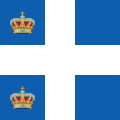Top Qs
Timeline
Chat
Perspective
Crown Prince of Greece
Heir to the defunct throne of Greece From Wikipedia, the free encyclopedia
Remove ads
The Crown Prince of Greece (Greek: Διάδοχος, romanized: Diadochos) is the heir apparent or presumptive to the defunct throne of Greece. Since the abolition of the Greek monarchy by the then-ruling military regime on 1 June 1973, it is merely considered a courtesy title.
You can help expand this article with text translated from the corresponding article in French. (April 2014) Click [show] for important translation instructions.
|

Remove ads
Title
Neither the constitution of 1844 or 1864, which served as the basis for other fundamental laws of the Kingdom of Greece, recognised titles of nobility. On the contrary, they prohibited even the sovereign from conferring such titles.[1][a][b]
As a result, the heir apparent was usually referred to simply as "the diadochos" by virtue of his function, rather than as a title. The word diadochos (διάδοχος) simply means "successor, he who collects the estate". This is a deverbal of διαδέχομαι (diadéchomai), "receive by succession",[2] and has been used since the Archaic period for heirs-apparent.[3] The most famous bearers of the title were the Diadochi, the "Successors" of Alexander the Great, who contended with each other for the spoils of his empire.[4]
Only one crown prince, the future Constantine I, bore a separate title of nobility, that of "Duke of Sparta." It was created soon after his birth in 1868. However, that caused a political scandal as many viewed it as a violation of the constitution. In the end, the creation was ultimately ratified by the Greek parliament, while the title's use within Greece continued to be highly restricted.[5]
Remove ads
Succession
Summarize
Perspective
The London Conference of 1832, established a semi-salic line of succession which would pass the crown to Otto I's descendants, or his younger brothers, should he have no issue. It was also decided that in no case would the crowns of Greece and Bavaria be joined in a personal union.[6]
The continued inability of Otto and Queen Amalia to have children was a permanent threat to the stability of Otto's throne: the 1844 constitution insisted that Otto's successor had to be Orthodox, but as the king was childless, the only possible heirs were his younger brothers, Luitpold and Adalbert. The staunch Catholicism of the Wittelsbachs complicated matters, as Luitpold refused to convert and Adalbert married Infanta Amalia of Spain. The sons of Adalbert, and especially the eldest, Ludwig Ferdinand, were now considered the most likely candidates, but due to the issue of religion, no definite arrangements were ever made prior to Otto's deposition in 1862.[7]
Since the establishment of the constitution of 1952, the daughters of the sovereign came after their brothers in the order of succession to the throne.
When Constantine II succeeded Paul I in 1964, his sister became heir presumptive according to the 1952 Constitution but that caused a constitutional crisis because his father's cousin Prince Peter who declared himself heir to the throne on the pretext that female dynasts had been unlawfully granted succession rights, but Prince Peter lost his succession rights by marrying Irina Ovtchinnikova in 1939. Also at the time Constantine's older sister Princess Sophia married the future Juan Carlos I in 1962 and cousin Prince Philip married Queen Elizabeth II in 1947 renounced their rights for their descendants.
Remove ads
Personal standard
- 1914 version
- 1935 version
List of heirs to the Greek throne
In pretense
Remove ads
See also
Notes
- On 11 June 1917, King Constantine I was deposed from the throne, and his second son, Prince Alexander was selected by the Allies of World War I to act as a puppet king, after the refusal of both Constantine I's eldest son (Crown Prince George) and brother (Prince George). Eventually all the members of the royal family went into exile, except for Alexander himself. King Alexander considered himself as merely a regent in the name of his father, as neither he nor his elder brother had abdicated. On 25 October 1920, Alexander died of sepsis after being bit by a monkey on 2 October. Still unwilling to restore Constantine I to the throne, the government of Eleftherios Venizelos offered the crown to his third son (Prince Paul), receiving another refusal on the same grounds of loyalty to Constantine I. On 14 November, Venizelos was defeated in the 1920 Greek legislative election and the new government of Dimitrios Rallis asked Queen Dowager Olga (who was allowed to return to Greece as Alexander was dying) to assume the regency until Constantine I's restoration on 19 December, after a referendum.
- In 1952, the law of succession was changed from agnatic primogeniture to male-preference primogeniture.
- In 1962, Princess Sophia renounced her claim to the throne, in order to marry Juan Carlos, Prince of Asturias.
Remove ads
References
Bibliography
Wikiwand - on
Seamless Wikipedia browsing. On steroids.
Remove ads


